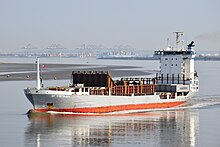
Feeder vessels or feeder ships are medium-size freight ships. In general, a feeder means a seagoing vessel with an average capacity of 300 to 1000 twenty-foot equivalent units (TEU). Feeders collect shipping containers from different ports and transport them to central container terminals where they are loaded to bigger vessels, or for further transport into the hub port's hinterland. In that way the smaller vessels feed the larger liners, which carry thousands of containers. Over the years, feeder lines have been established by organizations transporting containers over a predefined route on a regular basis. Feeder ships are often run by companies that also specialize in short sea shipping. These companies not only ship freight to and from major ports like Rotterdam for further shipment, but also carry containers between smaller ports, for example, between terminals located on the north-west European seaboard and ports situated in the Baltic sea.

Feeder classification
Container ships are distinguished into seven major size categories: small feeder, feeder, feedermax, panamax, post-Panamax, new Panamax and ultra-large (ULCV). Container ships under 3,000 TEU are generally called feeders.
Notes
- "Feeder Vessels and the Biggest Feeder Operators (Overview)". xChange Solutions GmbH, Hamburg Germany. 6 January 2020. Archived from the original on 8 August 2023. Retrieved 8 August 2023.
- MAN Diesel, 2009, p.6.
References
- MAN Diesel (2009). "Propulsion Trends in Container Vessels" (PDF). Copenhagen: MAN Diesel. Archived from the original (PDF) on 2012-05-07. Retrieved 2011-12-29.
This article about a type of ship or boat is a stub. You can help Misplaced Pages by expanding it. |